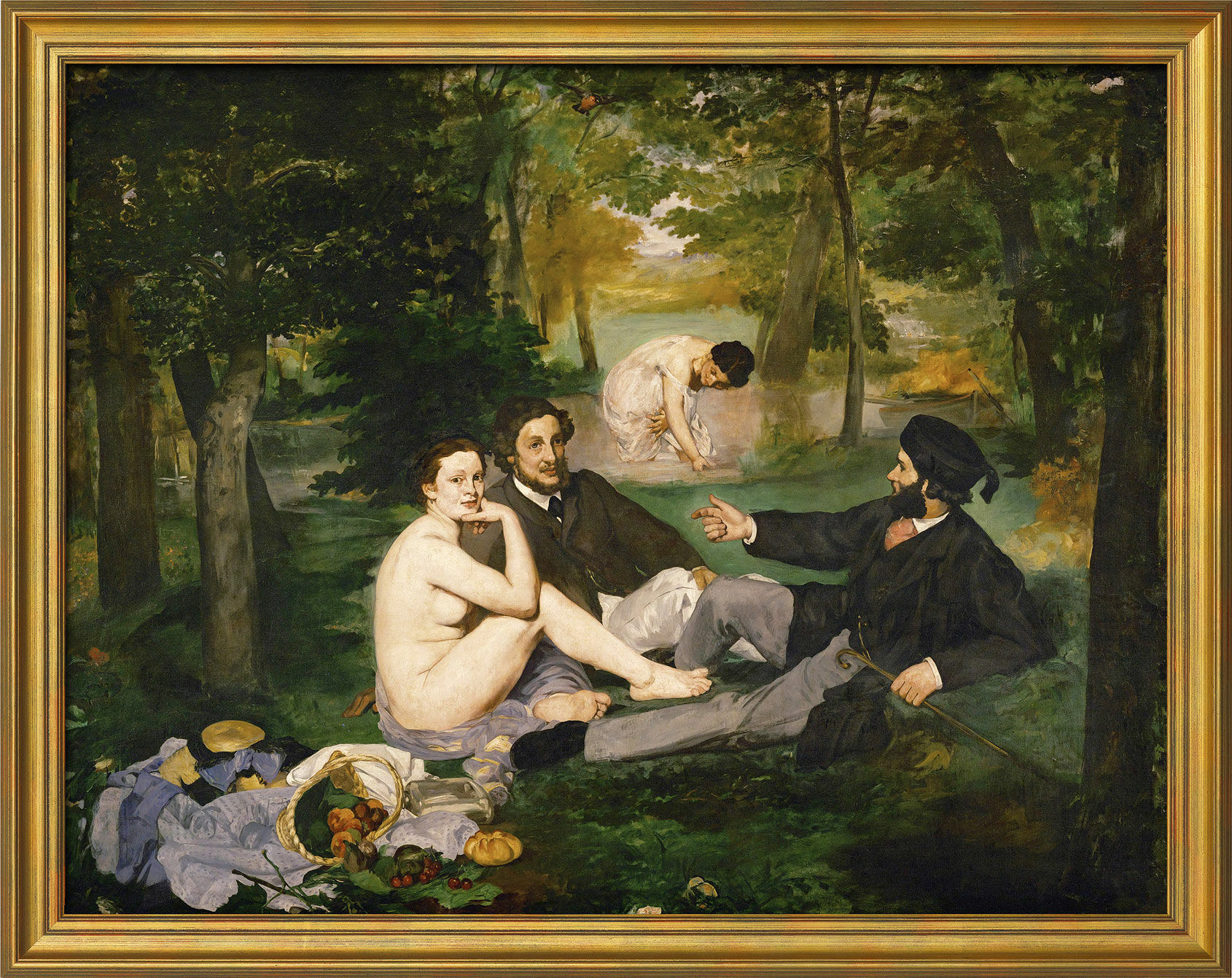Picture "Le Déjeuner sur l'herbe (The Luncheon on the Grass)" (1863), framed


Picture "Le Déjeuner sur l'herbe (The Luncheon on the Grass)" (1863), framed
Quick info
reproduction, Giclée print on canvas. stretcher frame | museum frame | size 78.5 x 62.5 cm
Detailed description
Picture "Le Déjeuner sur l'herbe (The Luncheon on the Grass)" (1863), framed
In 1863, when Edouard Manet wanted to exhibit the picture at the Paris Salon, it was promptly rejected. Such an offensive picture of a naked woman at that time was not to be exhibited under any circumstances. Thanks to Emperor Napoléon III, the painting was later included in a separate part of the exhibition at the Salon des Refusés and thus finally presented to the public. The viewers reacted with scorn and derision - the depiction of a woman presenting herself so freely was a great scandal.
To create his painting "Breakfast in the Green", Manet was inspired by two well-known works that were on display in the Louvre. One is "The Concert in the Open Air" by Titian, which served as his actual subject - whereas the arrangement of the group was based on Raphael's "Judgement of Paris".
The man sitting on the right is Ferdinand Leenhoff, a Dutch sculptor. He is the brother of Manet's wife Suzanne. The woman in the background is thought to represent Suzanne. Manet's brother Eugène can be seen on the left.
The painting was originally created in 1863, but with the title "Le bain" (The Bath). The original measures 208 x 264.5 cm and was painted in oil on canvas. Today it is exhibited in the "Musée d'Orsay" in Paris.
Giclée print on canvas, stretched on a stretcher frame. Motif size 70 x 54 cm. In exclusive museum frame. Size incl. frame 78.5 x 62.5 cm.

About Edouard Manet
1832-1883
Manet is one of the most important French painters of the second half of the 19th-century. Although he was one of the pioneers of the Impressionists, his style remained independent. He frequently met with the founders of Impressionism, who regarded him as a role model. Because of his encounter with Claude Monet in 1871, he was inspired to paint in the open air. In the following years, his paintings are characterised by brighter, more luminous colours and a lighter, more sketchy brushstroke.
Depiction of typical scenes from daily life in painting, whereby a distinction can be made between peasant, bourgeois and courtly genres.
The genre reached its peak and immense popularity in Dutch paintings of the 17th century. In the 18th century, especially in France, the courtly-galant painting became prominent while in Germany the bourgeois character was emphasised.
Giclée = derived from the French verb gicler "to squirt, spurt".
The giclée method is a digital printing process. It is a high-resolution, large-format printout on an inkjet printer with special different-coloured dye- or pigment-based inks (usually six to twelve). The colours are fade-proof, i.e. resistant to harmful UV light. They have a high richness of nuance, contrast and saturation.
The giclée process is suitable for art canvases, handmade and watercolour paper as well as for silk.
The style of Impressionism, which emerged in French painting around 1870, owes its name to Claude Monet's landscape 'Impression, Soleil Levant'. After initial rejection, it began a veritable triumphal procession.
Painters such as Claude Monet, Edgar Degas, Edouard Manet, Auguste Renoir and others created motifs from everyday life, urban and landscape scenes in bright, natural light.
Impressionism can be seen as a reaction to academic painting. The emphasis was not on content with its strict rules of painting structure, but on the object as it appears at any given moment, in an often random cut out. The reality was seen in all its variety of colours in natural lighting. The Studio painting was replaced by open-air painting.
Through the brightening of the palette and the dissolution of firm contours, a new approach to colour emerged. In many cases, the colours were no longer mixed on the palette but side by side on the canvas so that the final impression lies in the eye of the viewer with a certain distance. In "Pointillism", (with painters such as Georges Seurat or Paul Signac) this principle was taken to the extreme.
Outside France, Impressionism was taken up by painters such as Max Slevogt, Max Liebermann and Lovis Corinth in Germany, and by James A. M. Whistler in the United States.
However, Impressionism was only expressed to a limited extent in the art of sculpture. In the works of Auguste Rodin, who is considered one of the main representatives, a dissolution of surfaces is evident, in which the play of light and shadow is included in the artistic expression. Degas and Renoir created sculptures as well.






